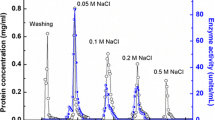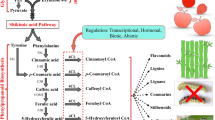Abstract.
Three of the nitrilase isoenzymes of Arabidopsis thaliana (L.) Heynh. are located on chromosome III in tandem and these genes (NIT2/NIT1/NIT3 in the 5′→3′ direction) encode highly similar polypeptides. Copy DNAs encompassing the entire coding sequences for all three nitrilases were expressed in Escherichia coli as fusion proteins containing a C-terminal hexahistidine extension. All three nitrilases were obtained as enzymatically active proteins, and their characteristics were determined, including a detailed comparative analysis of their substrate preferences. All three nitrilases converted indole-3-acetonitrile (IAN) to indole-3-acetic acid (IAA), albeit, compared to the most effective substrates found, phenylpropionitrile (PPN), allylcyanide, (phenylthio)acetonitrile and (methylthio)acetonitrile, with low affinity and velocity. The preferred substrates are either naturally occurring substrates, which may originate from glucosinolate breakdown, or they are close relatives of these. Thus, a major function of NIT1, NIT2 and NIT3 is assigned to be the conversion to carboxylic acids of nitriles from glucosinolate turnover or degradation. While all nitrilases exhibit a similar pH optimum around neutral, and NIT1 and NIT3 exhibit a similar temperature optimum around 30 °C independent of the substrate analyzed (IAN, PPN), NIT2 showed a remarkably different temperature optimum for IAN (15 °C) and PPN (35–40 °C). A potential role for NIT2 in breaking seed dormancy in A. thaliana by low temperatures (stratification), however, was ruled out, although NIT2 was the predominantly expressed nitrilase isoform in developing embryos and in germinating seeds, as judged from an analysis of β-glucuronidase reporter gene expression under the control of the promoters of the four isogenes. It is possible that NIT2 is involved in supplying IAA during seed development rather than during stratification.
Similar content being viewed by others
Author information
Authors and Affiliations
Additional information
Received: 13 May 2000 / Accepted: 14 August 2000
Rights and permissions
About this article
Cite this article
Vorwerk, S., Biernacki, S., Hillebrand, H. et al. Enzymatic characterization of the recombinant Arabidopsis thaliana nitrilase subfamily encoded by the NIT2/NIT1/NIT3-gene cluster. Planta 212, 508–516 (2001). https://doi.org/10.1007/s004250000420
Issue Date:
DOI: https://doi.org/10.1007/s004250000420




